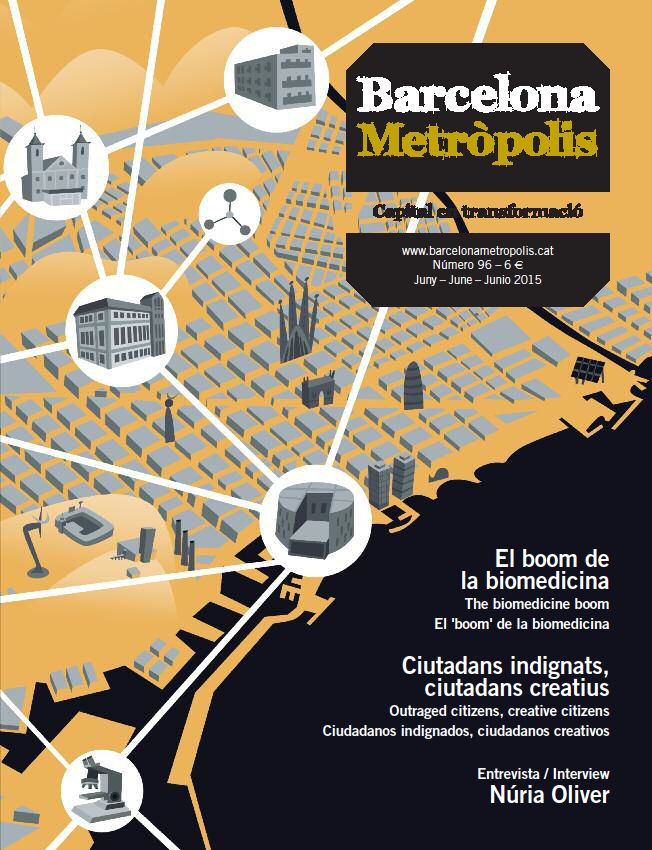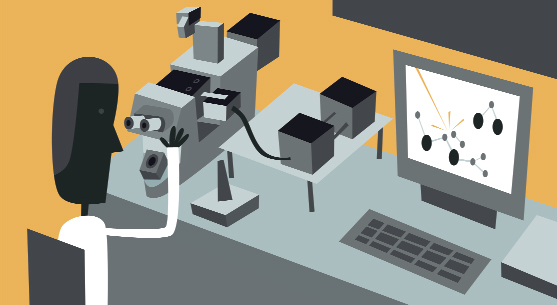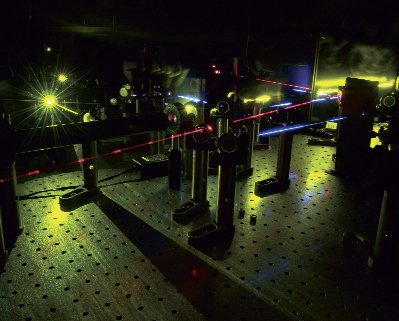Photonics encompasses the science of light and its derivative technology. The Institute of Photonic Sciences (ICFO) is one of the Catalan centres with dozens of researchers dedicated to improving medical diagnoses and the effectiveness of therapies, as well as delving deeper into the origins of biological processes.
When Robert Hooke examined a slice of cork under his microscope with a magnifying power of fifty, he saw a tissue of regular cavities. It was 1665 and Hooke had just discovered cells, subsequently considered to be the smallest living structures. Since then, the details of the birth, metabolism, reproduction, differentiation and death of cells have increased along with the power of the lenses. Cellular biology begins and advances with the microscope. The fundamental mysteries of life lie on the horizon.
In the middle of the 19th century, Carl Zeiss (whose small microscope factory is now one of the trade’s global leaders) hired the academic Ernst Abbe to take the capacity of his lenses to the limit. Unfortunately, Abbe soon found that limit. Because light is a wave, diffraction limits the resolution of an image to details of a size comparable with the wavelength of the light used; this means 200 millionths of a millimetre for visible light. A single strand of hair is five hundred times bigger. A large part of the internal life of cells falls below Abbe’s limit. Will, then, the scope of cellular biology also die when the microscope reaches its limit?
Viruses hack into cellular mechanisms to replicate within an organism. Cancer is the result of a failure in the regulation of cell reproduction. Visualising these processes in vivo is crucial to remedying them. However, they are beyond the Abbe diffraction limit and therefore impossible to distinguish clearly. This idea horrified the young physicist Stefan Hell, who astonished the scientific world at the end of the 20th century by setting out to find a way to circumvent Abbe’s limit. Luckily for Hell, the development of the laser, nanotechnology, the ability to handle samples at the molecular level and a hefty dose of ingenuity enabled him to have detailed control over the interaction of light with the sample to such an extent that the light emitted from miniscule areas could be controlled. In 2014 he shared the Nobel Prize in Chemistry with Eric Betzig and William Moerner for the development of super-resolved fluorescence microscopy.
More light
In the 21st century super-resolution has continued to advance, thanks to the traditional collaboration between physics and biology. The latest issue of Cell magazine publishes the nanometric resolution image of the nanometric structure of DNA, the result of the combined efforts of the groups led by Melike Lakadamyali and María García-Parajó at the Institute of Photonic Sciences (ICFO) and Maria Pia Cosma at the Centre for Genomic Regulation (CRG). The results, related to the packaging of genetic information in DNA, have shed more light on the process of differentiation between stem cells. The fundamental mysteries of life lie on the horizon.
But photonics is not the only biofield which has been developing apace. Bioengineering, bioinformatics and biomathematics are just some of the many disciplines summoned by the enigmas of biology and making progress thanks to advances in nanotechnology. There are several research centres in Barcelona working on these matters: the Institute for Research in Biomedicine (IRB Barcelona), the CRG, the Catalan Institute of Nanoscience and Nanotechnology (ICN2), the Institute for Bioengineering of Catalonia (IBEC), the August Pi i Sunyer Biomedical Research Institute (IDIBAPS) and the Bellvitge Biomedical Research Institute (IDIBELL). Then there are groups from various universities, from the Spanish National Research Council (CSIC) and from diverse hospitals, all of which have dozens of researchers dedicated to improving medical diagnoses and the effectiveness of therapies, as well as delving deeper into the origins of biological processes. ICFO belongs to these ranks.
Non-invasive methods
While it is natural to begin an article about the use of light in biomedicine by talking about the ability to see, light also serves to diagnose and cure. For example, the ICFO group led by Romain Quidant uses metal nanoparticles to detect certain substances in a liquid. These nanoparticles are covered with antibodies designed to unite specifically with certain antigens (pathogens, biological markers of cancer cells, or any other substance of interest) and then light up. The response of the nanoparticles to light depends on whether they are free or bound to the molecule in question, thereby revealing their presence and concentration. It is a non-invasive method with a very high degree of sensitivity, which allows for early diagnosis and the ability to monitor the effectiveness of a therapy and to adjust its intensity to the limit in accordance with the results obtained.
Another example of diagnosis and therapy control is the research being conducted by the Medical Optics Group at ICFO, led by Turgut Durduran. In this case, they are studying the way in which light is absorbed or diverted when it passes through blood and tissue. In particularly fragile contexts with a critical dependence on reaction times, for instance in newborns with cerebral oxygen saturation deficit, non-intrusive, instantaneous and in situ flow monitoring is an invaluable tool.
The Medical Optics Group runs this programme in conjunction with various hospitals and research centres, including Vall d’Hebron, IDIBAPS and IDIBELL. At Hospital Clínic they are carrying out trials with cancer diagnoses and the control of anaesthesia administration during an operation; at Hospital de la Santa Creu i Sant Pau, they are monitoring the effectiveness of therapies on patients who have suffered a stroke or who are affected by obstructive sleep apnoea.
In summary, the fact that the interaction of light with human tissue, fluorescent molecules and nanoparticles has so many applications in biomedicine is a credit to the amazing developments in the art of generating and emitting light: of detecting it, turning it off and on again, guiding it, manipulating it, magnifying it… Photonics, that all-encompassing discipline on the science of light and the technologies based around it, is considered by the European Union to be one of the seven Key Enabling Technologies of the 21st century.
All of the ICFO healthcare and biophotonic programmes are funded by the Mir Puig Foundation, the Cellex Foundation and the “la Caixa” Foundation.






